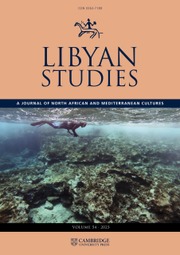No CrossRef data available.
Article contents
The Latin inscriptions of Cyrenaica: an overview
Published online by Cambridge University Press: 18 September 2024
Abstract
Although Greek was the dominant epigraphic language in Cyrenaica throughout the Classical period, Latin was introduced by Roman merchants and administrators at the time of the formation of the province of Crete and Cyrene c. 67 BC, and remained in use, albeit by a constant minority, until at least the fourth century AD, with the last well-dated Latin inscription dating from the Valentinian dynasty. The aim of this article is to provide an overview of Latin inscriptions in the region, based on the IR Cyrenaica 2020 corpus, which brings together hitherto scattered documents and also includes many texts published for the first time. After a general overview of the corpus in terms of geographical, typological and chronological distribution, we will look at the linguistic landscape of ancient Cyrenaica, focusing on the multilingualism of the region, the literacy of the populations, the borrowings from one language to another (Latinisms), and the influences of the western provinces on the Latin of the region, among other topics. Lastly, a series of Latin funerary inscriptions allow us to examine the multiple identities claimed by the populations, as well as the cultural influences between Greek-, Latin- and Libyan-speaking populations.
النقوش اللاتينية في برقة: نظرة عامة.
فرانسوا شيفولييه
على الرغم من أن اليونانية كانت اللغة الكتابية السائدة في برقة طوال الفترة الكلاسيكية، تم إدخال اللاتينية عن طريق الرومان التجار والإداريين في وقت تشكيل مقاطعة كريت - برقة حوالي عام 67 قبل الميلاد، وبقيت قيد الاستخدام، وإن كان بين الأقلية، باستمرار حتى القرن الرابع الميلادي على الأقل، مع أخر نقش لاتيني مؤرخ جيداً يعود تاريخه إلى أسرة فالنتينيان لبرقة 2020، التي تجمع وثائق متفرقة معاً، كما تتضمن العديد من IR الحاكمة. تهدف هذه المقالة إلى تقديم لمحة عامة عن النقوش اللاتينية في المنطقة، استناداً على مجموعة النصوص المنشورة لأول مرة. وبعد إعطاء نظرة عامة على المجموعة من الناحية الجغرافية، و التوزيع النمطي والزمني، سوف ننظر إلى المشهد اللغوي ببرقة القديمة، مع التركيز على التعددية اللغوية في المنطقة، و إلمام السكان بالقراءة والكتابة، والاقتراض من لغة إلى أخرى (اللاتينية)، وتأثيرات المقاطعات الغربية على اللغة اللاتينية في المنطقة، بالإضافة إلى مواضيع أخرى . وأخيرا، سلسلة من النقوش اللاتينية الجنائزية تسمح لنا بفحص الهويات المتعددة المزعومة من قبل السكان، فضلا عن التأثيرات الثقافية بين السكان الناطقين باليونانية، واللاتينية والليبية.
- Type
- Articles
- Information
- Copyright
- Copyright © The Author(s), 2024. Published by Cambridge University Press on behalf of the British Institute for Libyan & Northern African Studies


